Research Proposal: AIS and Decision-Making in Sydney Retail
VerifiedAdded on 2023/03/20
|21
|6407
|93
Report
AI Summary
This research proposal investigates the influence of Accounting Information Systems (AIS) on decision-making within retail businesses in Sydney, Australia. It examines the research background, problem statement, rationale, and research questions, including the impact of AIS, associated costs, and benefits. The study aims to explore the influence of AIS on organizational decision-making, determine cost factors in acquiring AIS, and investigate the benefits of AIS in the retail industry. The literature review covers the definition of AIS, its effects on organizations, the impact of AIS on decision-making, and the application of AIS in small-scale enterprises. The methodology section outlines the research philosophy, design, data collection methods, sampling, data analysis techniques, and ethical considerations. The expected outcome of the research is to inform retail businesses about the importance of implementing AIS and contribute to the existing body of research in accounting.
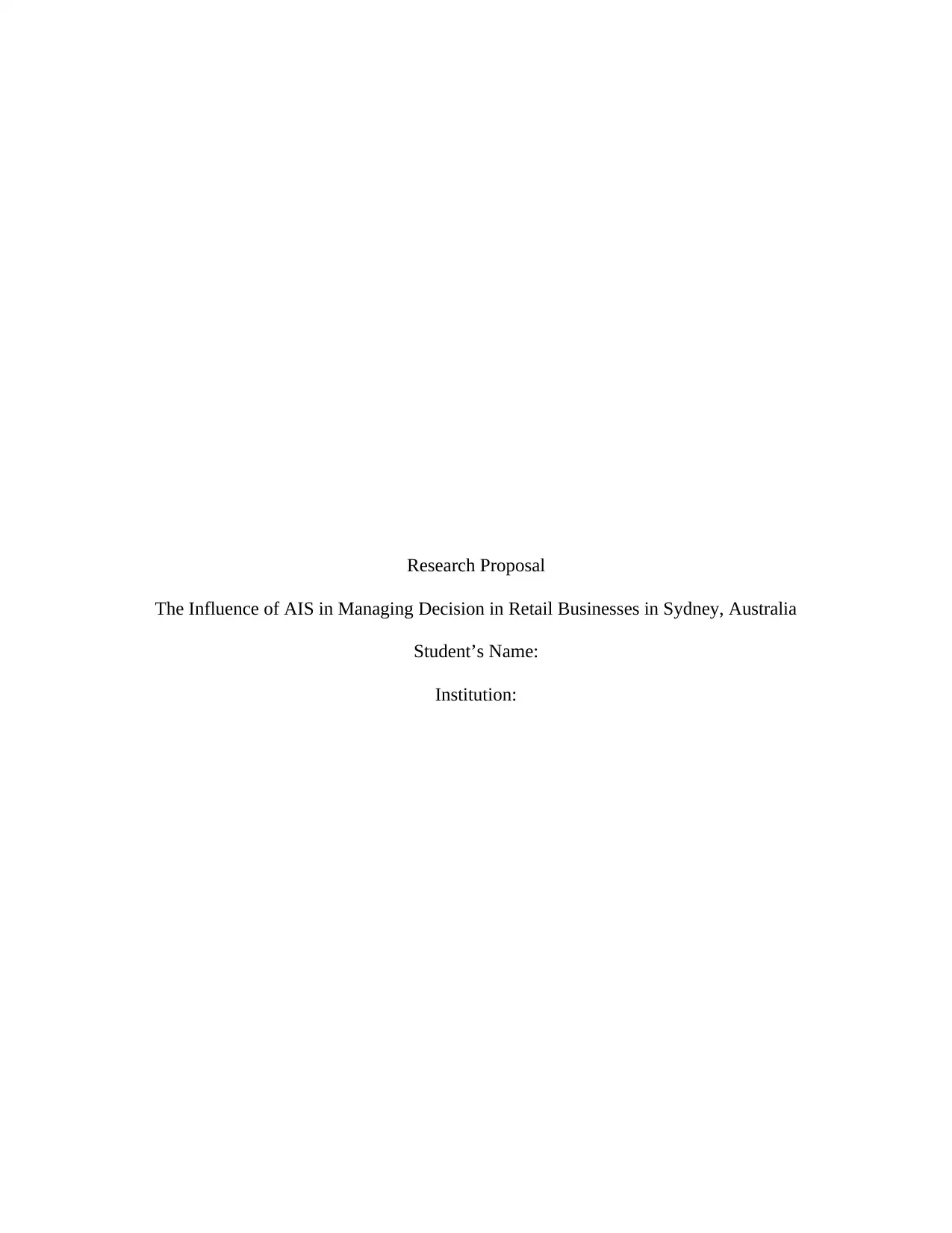
Research Proposal
The Influence of AIS in Managing Decision in Retail Businesses in Sydney, Australia
Student’s Name:
Institution:
The Influence of AIS in Managing Decision in Retail Businesses in Sydney, Australia
Student’s Name:
Institution:
Paraphrase This Document
Need a fresh take? Get an instant paraphrase of this document with our AI Paraphraser
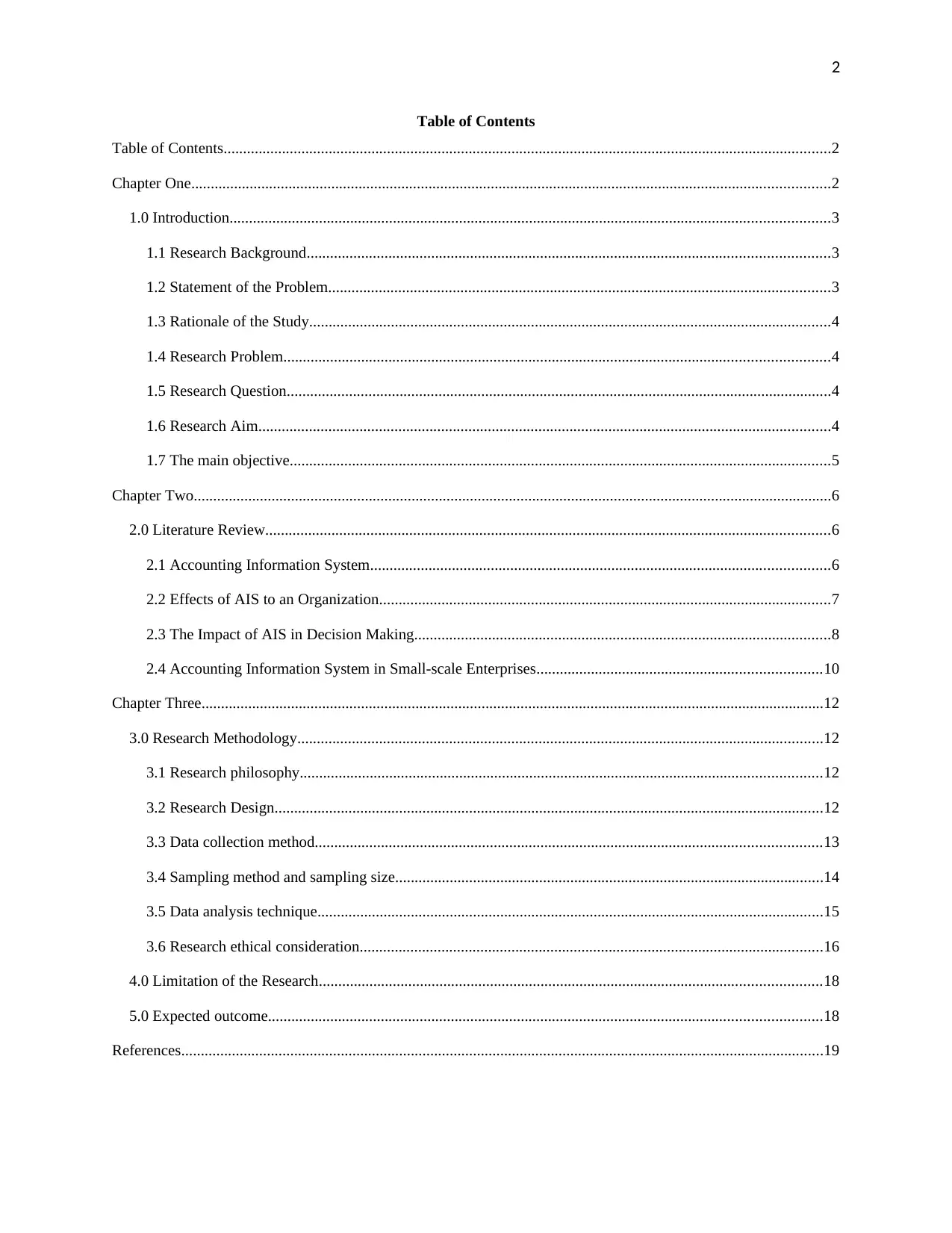
2
Table of Contents
Table of Contents............................................................................................................................................................2
Chapter One....................................................................................................................................................................2
1.0 Introduction..........................................................................................................................................................3
1.1 Research Background......................................................................................................................................3
1.2 Statement of the Problem.................................................................................................................................3
1.3 Rationale of the Study......................................................................................................................................4
1.4 Research Problem............................................................................................................................................4
1.5 Research Question............................................................................................................................................4
1.6 Research Aim...................................................................................................................................................4
1.7 The main objective...........................................................................................................................................5
Chapter Two....................................................................................................................................................................6
2.0 Literature Review.................................................................................................................................................6
2.1 Accounting Information System......................................................................................................................6
2.2 Effects of AIS to an Organization....................................................................................................................7
2.3 The Impact of AIS in Decision Making...........................................................................................................8
2.4 Accounting Information System in Small-scale Enterprises.........................................................................10
Chapter Three................................................................................................................................................................12
3.0 Research Methodology.......................................................................................................................................12
3.1 Research philosophy......................................................................................................................................12
3.2 Research Design.............................................................................................................................................12
3.3 Data collection method..................................................................................................................................13
3.4 Sampling method and sampling size..............................................................................................................14
3.5 Data analysis technique..................................................................................................................................15
3.6 Research ethical consideration.......................................................................................................................16
4.0 Limitation of the Research.................................................................................................................................18
5.0 Expected outcome..............................................................................................................................................18
References.....................................................................................................................................................................19
Table of Contents
Table of Contents............................................................................................................................................................2
Chapter One....................................................................................................................................................................2
1.0 Introduction..........................................................................................................................................................3
1.1 Research Background......................................................................................................................................3
1.2 Statement of the Problem.................................................................................................................................3
1.3 Rationale of the Study......................................................................................................................................4
1.4 Research Problem............................................................................................................................................4
1.5 Research Question............................................................................................................................................4
1.6 Research Aim...................................................................................................................................................4
1.7 The main objective...........................................................................................................................................5
Chapter Two....................................................................................................................................................................6
2.0 Literature Review.................................................................................................................................................6
2.1 Accounting Information System......................................................................................................................6
2.2 Effects of AIS to an Organization....................................................................................................................7
2.3 The Impact of AIS in Decision Making...........................................................................................................8
2.4 Accounting Information System in Small-scale Enterprises.........................................................................10
Chapter Three................................................................................................................................................................12
3.0 Research Methodology.......................................................................................................................................12
3.1 Research philosophy......................................................................................................................................12
3.2 Research Design.............................................................................................................................................12
3.3 Data collection method..................................................................................................................................13
3.4 Sampling method and sampling size..............................................................................................................14
3.5 Data analysis technique..................................................................................................................................15
3.6 Research ethical consideration.......................................................................................................................16
4.0 Limitation of the Research.................................................................................................................................18
5.0 Expected outcome..............................................................................................................................................18
References.....................................................................................................................................................................19
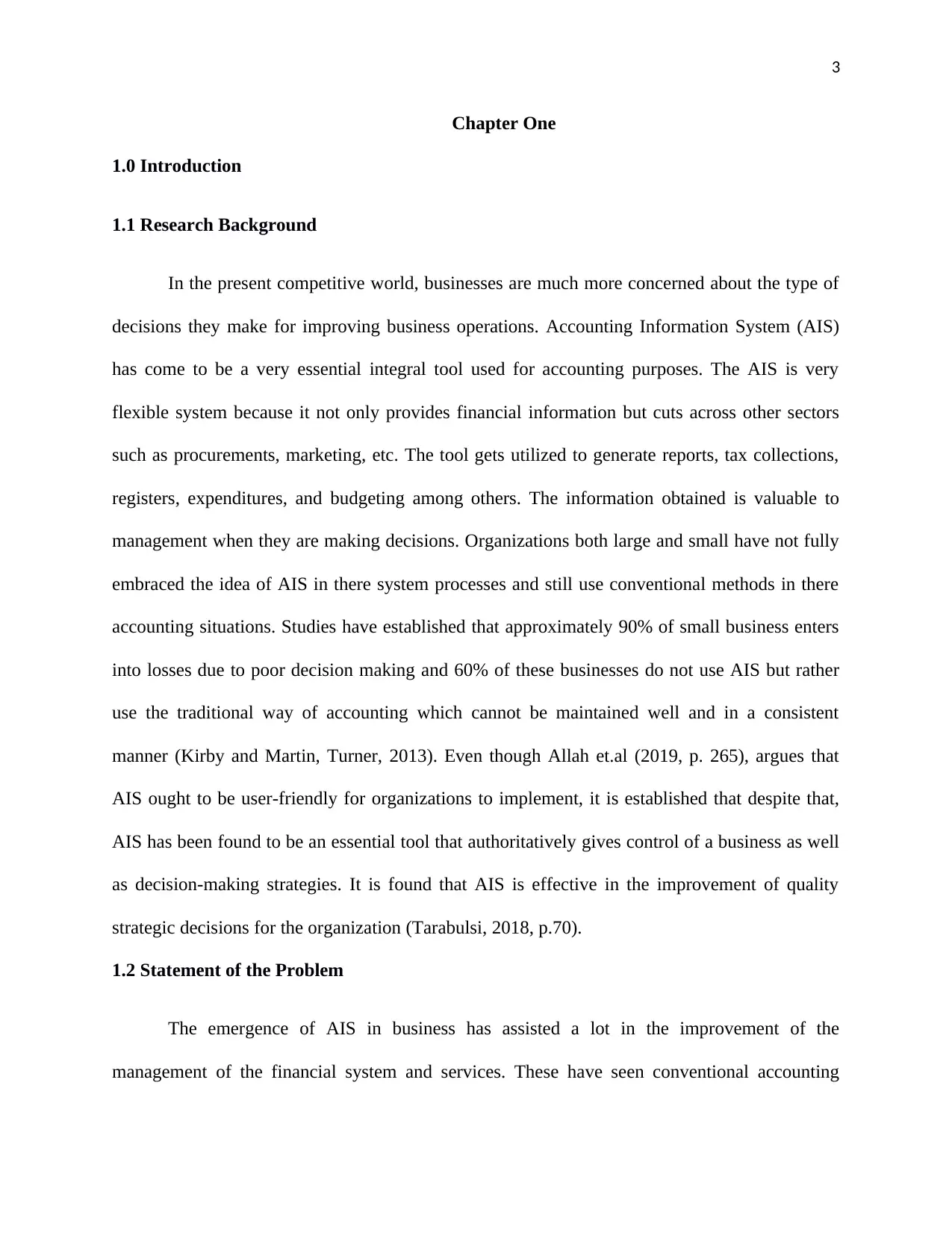
3
Chapter One
1.0 Introduction
1.1 Research Background
In the present competitive world, businesses are much more concerned about the type of
decisions they make for improving business operations. Accounting Information System (AIS)
has come to be a very essential integral tool used for accounting purposes. The AIS is very
flexible system because it not only provides financial information but cuts across other sectors
such as procurements, marketing, etc. The tool gets utilized to generate reports, tax collections,
registers, expenditures, and budgeting among others. The information obtained is valuable to
management when they are making decisions. Organizations both large and small have not fully
embraced the idea of AIS in there system processes and still use conventional methods in there
accounting situations. Studies have established that approximately 90% of small business enters
into losses due to poor decision making and 60% of these businesses do not use AIS but rather
use the traditional way of accounting which cannot be maintained well and in a consistent
manner (Kirby and Martin, Turner, 2013). Even though Allah et.al (2019, p. 265), argues that
AIS ought to be user-friendly for organizations to implement, it is established that despite that,
AIS has been found to be an essential tool that authoritatively gives control of a business as well
as decision-making strategies. It is found that AIS is effective in the improvement of quality
strategic decisions for the organization (Tarabulsi, 2018, p.70).
1.2 Statement of the Problem
The emergence of AIS in business has assisted a lot in the improvement of the
management of the financial system and services. These have seen conventional accounting
Chapter One
1.0 Introduction
1.1 Research Background
In the present competitive world, businesses are much more concerned about the type of
decisions they make for improving business operations. Accounting Information System (AIS)
has come to be a very essential integral tool used for accounting purposes. The AIS is very
flexible system because it not only provides financial information but cuts across other sectors
such as procurements, marketing, etc. The tool gets utilized to generate reports, tax collections,
registers, expenditures, and budgeting among others. The information obtained is valuable to
management when they are making decisions. Organizations both large and small have not fully
embraced the idea of AIS in there system processes and still use conventional methods in there
accounting situations. Studies have established that approximately 90% of small business enters
into losses due to poor decision making and 60% of these businesses do not use AIS but rather
use the traditional way of accounting which cannot be maintained well and in a consistent
manner (Kirby and Martin, Turner, 2013). Even though Allah et.al (2019, p. 265), argues that
AIS ought to be user-friendly for organizations to implement, it is established that despite that,
AIS has been found to be an essential tool that authoritatively gives control of a business as well
as decision-making strategies. It is found that AIS is effective in the improvement of quality
strategic decisions for the organization (Tarabulsi, 2018, p.70).
1.2 Statement of the Problem
The emergence of AIS in business has assisted a lot in the improvement of the
management of the financial system and services. These have seen conventional accounting
⊘ This is a preview!⊘
Do you want full access?
Subscribe today to unlock all pages.

Trusted by 1+ million students worldwide
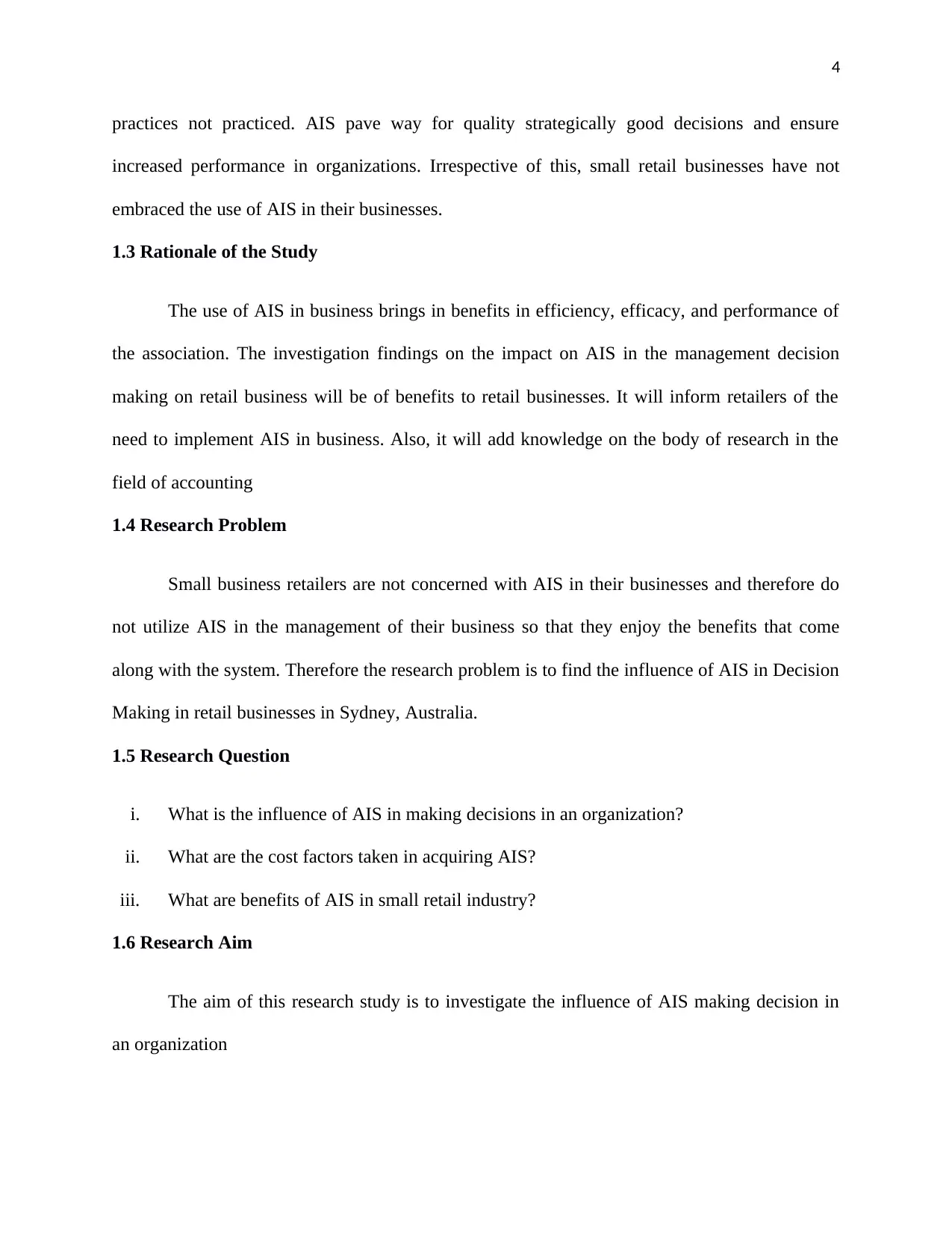
4
practices not practiced. AIS pave way for quality strategically good decisions and ensure
increased performance in organizations. Irrespective of this, small retail businesses have not
embraced the use of AIS in their businesses.
1.3 Rationale of the Study
The use of AIS in business brings in benefits in efficiency, efficacy, and performance of
the association. The investigation findings on the impact on AIS in the management decision
making on retail business will be of benefits to retail businesses. It will inform retailers of the
need to implement AIS in business. Also, it will add knowledge on the body of research in the
field of accounting
1.4 Research Problem
Small business retailers are not concerned with AIS in their businesses and therefore do
not utilize AIS in the management of their business so that they enjoy the benefits that come
along with the system. Therefore the research problem is to find the influence of AIS in Decision
Making in retail businesses in Sydney, Australia.
1.5 Research Question
i. What is the influence of AIS in making decisions in an organization?
ii. What are the cost factors taken in acquiring AIS?
iii. What are benefits of AIS in small retail industry?
1.6 Research Aim
The aim of this research study is to investigate the influence of AIS making decision in
an organization
practices not practiced. AIS pave way for quality strategically good decisions and ensure
increased performance in organizations. Irrespective of this, small retail businesses have not
embraced the use of AIS in their businesses.
1.3 Rationale of the Study
The use of AIS in business brings in benefits in efficiency, efficacy, and performance of
the association. The investigation findings on the impact on AIS in the management decision
making on retail business will be of benefits to retail businesses. It will inform retailers of the
need to implement AIS in business. Also, it will add knowledge on the body of research in the
field of accounting
1.4 Research Problem
Small business retailers are not concerned with AIS in their businesses and therefore do
not utilize AIS in the management of their business so that they enjoy the benefits that come
along with the system. Therefore the research problem is to find the influence of AIS in Decision
Making in retail businesses in Sydney, Australia.
1.5 Research Question
i. What is the influence of AIS in making decisions in an organization?
ii. What are the cost factors taken in acquiring AIS?
iii. What are benefits of AIS in small retail industry?
1.6 Research Aim
The aim of this research study is to investigate the influence of AIS making decision in
an organization
Paraphrase This Document
Need a fresh take? Get an instant paraphrase of this document with our AI Paraphraser
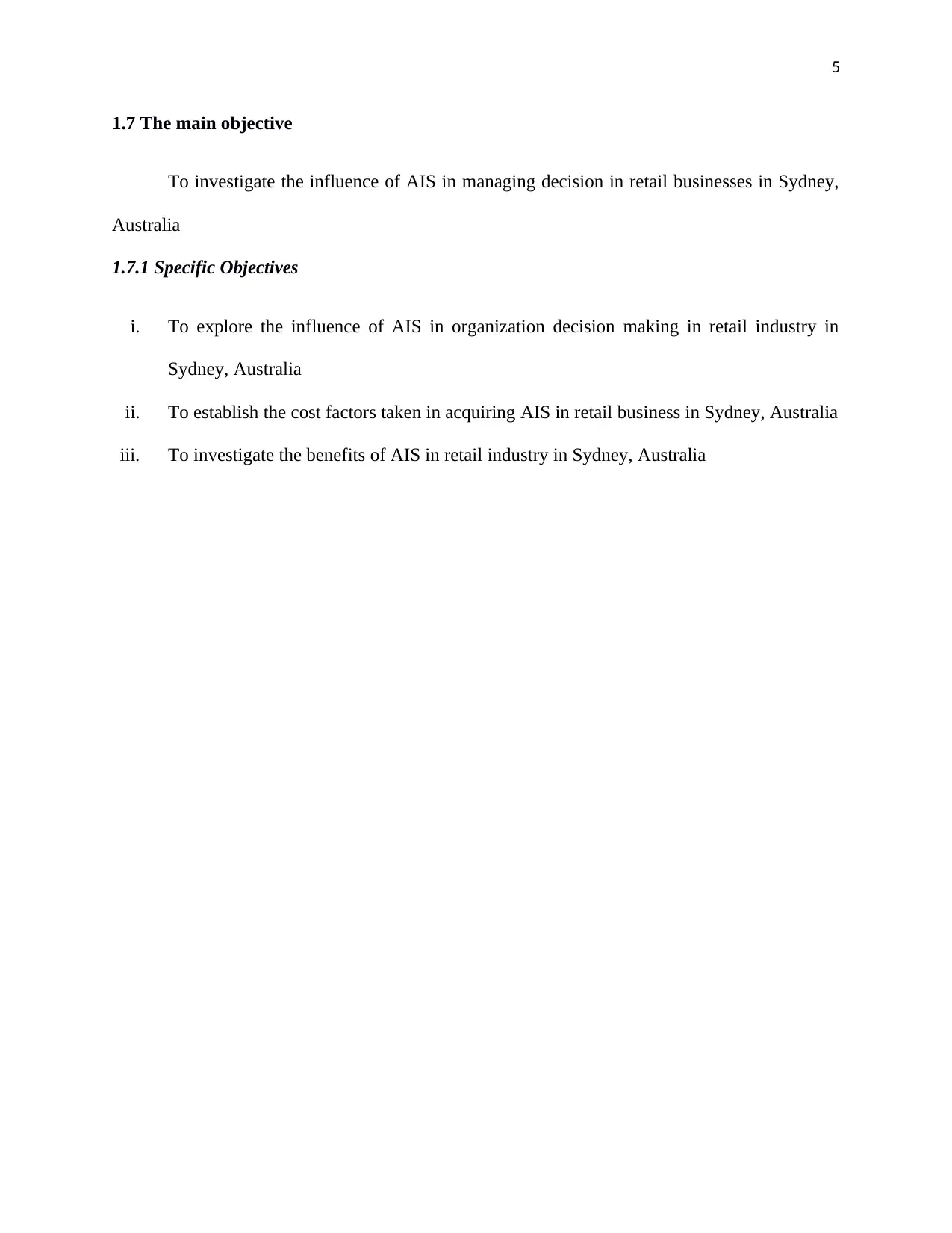
5
1.7 The main objective
To investigate the influence of AIS in managing decision in retail businesses in Sydney,
Australia
1.7.1 Specific Objectives
i. To explore the influence of AIS in organization decision making in retail industry in
Sydney, Australia
ii. To establish the cost factors taken in acquiring AIS in retail business in Sydney, Australia
iii. To investigate the benefits of AIS in retail industry in Sydney, Australia
1.7 The main objective
To investigate the influence of AIS in managing decision in retail businesses in Sydney,
Australia
1.7.1 Specific Objectives
i. To explore the influence of AIS in organization decision making in retail industry in
Sydney, Australia
ii. To establish the cost factors taken in acquiring AIS in retail business in Sydney, Australia
iii. To investigate the benefits of AIS in retail industry in Sydney, Australia
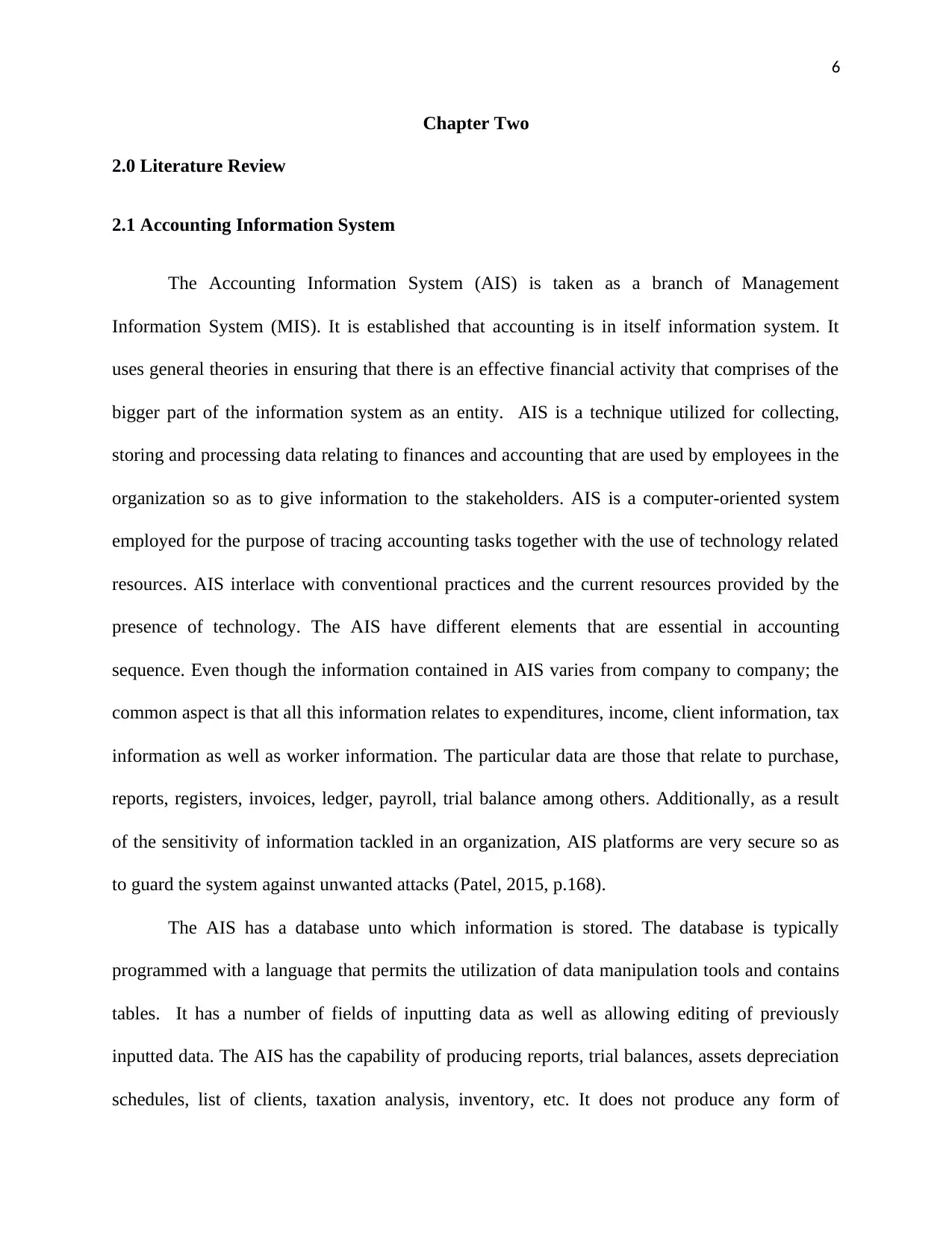
6
Chapter Two
2.0 Literature Review
2.1 Accounting Information System
The Accounting Information System (AIS) is taken as a branch of Management
Information System (MIS). It is established that accounting is in itself information system. It
uses general theories in ensuring that there is an effective financial activity that comprises of the
bigger part of the information system as an entity. AIS is a technique utilized for collecting,
storing and processing data relating to finances and accounting that are used by employees in the
organization so as to give information to the stakeholders. AIS is a computer-oriented system
employed for the purpose of tracing accounting tasks together with the use of technology related
resources. AIS interlace with conventional practices and the current resources provided by the
presence of technology. The AIS have different elements that are essential in accounting
sequence. Even though the information contained in AIS varies from company to company; the
common aspect is that all this information relates to expenditures, income, client information, tax
information as well as worker information. The particular data are those that relate to purchase,
reports, registers, invoices, ledger, payroll, trial balance among others. Additionally, as a result
of the sensitivity of information tackled in an organization, AIS platforms are very secure so as
to guard the system against unwanted attacks (Patel, 2015, p.168).
The AIS has a database unto which information is stored. The database is typically
programmed with a language that permits the utilization of data manipulation tools and contains
tables. It has a number of fields of inputting data as well as allowing editing of previously
inputted data. The AIS has the capability of producing reports, trial balances, assets depreciation
schedules, list of clients, taxation analysis, inventory, etc. It does not produce any form of
Chapter Two
2.0 Literature Review
2.1 Accounting Information System
The Accounting Information System (AIS) is taken as a branch of Management
Information System (MIS). It is established that accounting is in itself information system. It
uses general theories in ensuring that there is an effective financial activity that comprises of the
bigger part of the information system as an entity. AIS is a technique utilized for collecting,
storing and processing data relating to finances and accounting that are used by employees in the
organization so as to give information to the stakeholders. AIS is a computer-oriented system
employed for the purpose of tracing accounting tasks together with the use of technology related
resources. AIS interlace with conventional practices and the current resources provided by the
presence of technology. The AIS have different elements that are essential in accounting
sequence. Even though the information contained in AIS varies from company to company; the
common aspect is that all this information relates to expenditures, income, client information, tax
information as well as worker information. The particular data are those that relate to purchase,
reports, registers, invoices, ledger, payroll, trial balance among others. Additionally, as a result
of the sensitivity of information tackled in an organization, AIS platforms are very secure so as
to guard the system against unwanted attacks (Patel, 2015, p.168).
The AIS has a database unto which information is stored. The database is typically
programmed with a language that permits the utilization of data manipulation tools and contains
tables. It has a number of fields of inputting data as well as allowing editing of previously
inputted data. The AIS has the capability of producing reports, trial balances, assets depreciation
schedules, list of clients, taxation analysis, inventory, etc. It does not produce any form of
⊘ This is a preview!⊘
Do you want full access?
Subscribe today to unlock all pages.

Trusted by 1+ million students worldwide
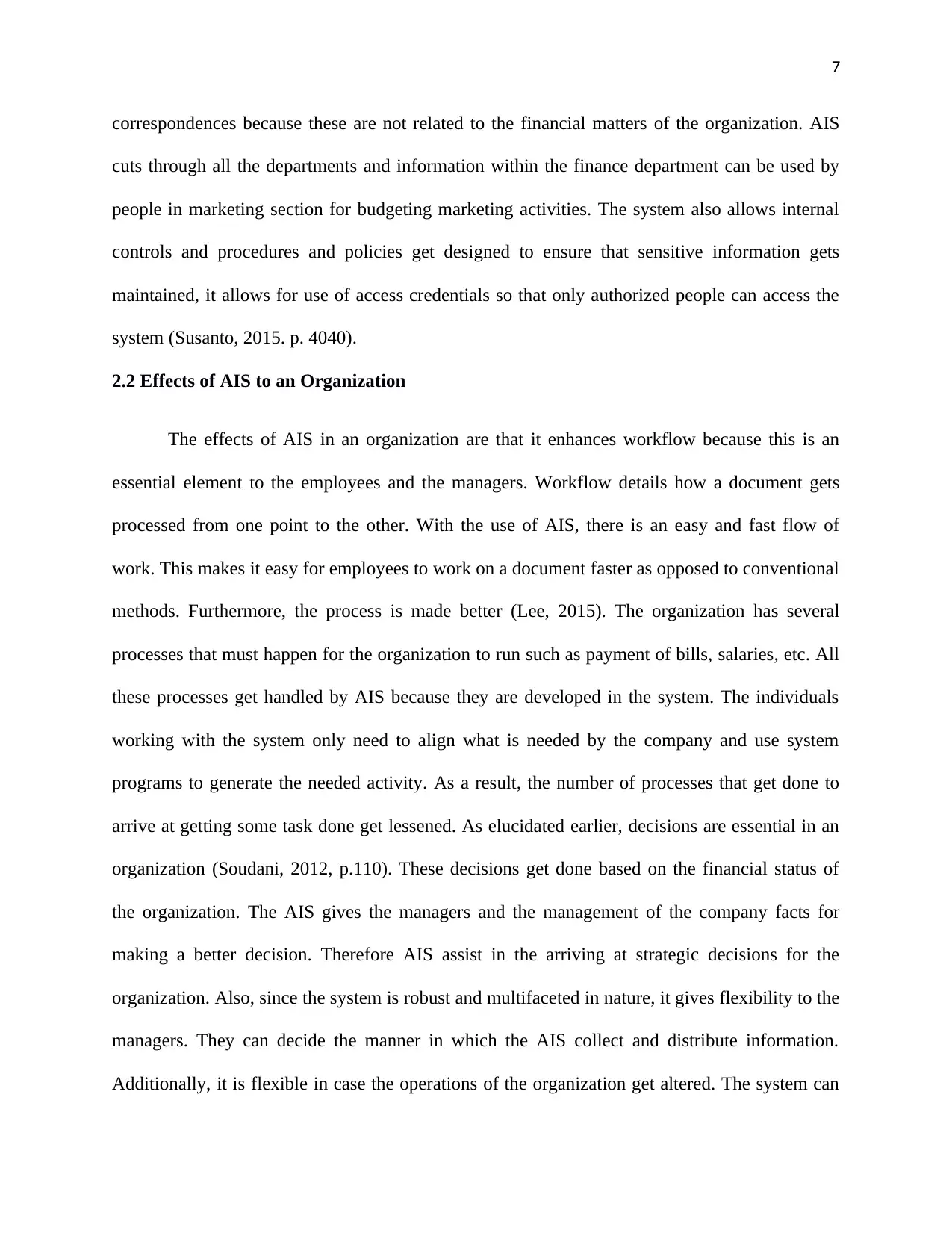
7
correspondences because these are not related to the financial matters of the organization. AIS
cuts through all the departments and information within the finance department can be used by
people in marketing section for budgeting marketing activities. The system also allows internal
controls and procedures and policies get designed to ensure that sensitive information gets
maintained, it allows for use of access credentials so that only authorized people can access the
system (Susanto, 2015. p. 4040).
2.2 Effects of AIS to an Organization
The effects of AIS in an organization are that it enhances workflow because this is an
essential element to the employees and the managers. Workflow details how a document gets
processed from one point to the other. With the use of AIS, there is an easy and fast flow of
work. This makes it easy for employees to work on a document faster as opposed to conventional
methods. Furthermore, the process is made better (Lee, 2015). The organization has several
processes that must happen for the organization to run such as payment of bills, salaries, etc. All
these processes get handled by AIS because they are developed in the system. The individuals
working with the system only need to align what is needed by the company and use system
programs to generate the needed activity. As a result, the number of processes that get done to
arrive at getting some task done get lessened. As elucidated earlier, decisions are essential in an
organization (Soudani, 2012, p.110). These decisions get done based on the financial status of
the organization. The AIS gives the managers and the management of the company facts for
making a better decision. Therefore AIS assist in the arriving at strategic decisions for the
organization. Also, since the system is robust and multifaceted in nature, it gives flexibility to the
managers. They can decide the manner in which the AIS collect and distribute information.
Additionally, it is flexible in case the operations of the organization get altered. The system can
correspondences because these are not related to the financial matters of the organization. AIS
cuts through all the departments and information within the finance department can be used by
people in marketing section for budgeting marketing activities. The system also allows internal
controls and procedures and policies get designed to ensure that sensitive information gets
maintained, it allows for use of access credentials so that only authorized people can access the
system (Susanto, 2015. p. 4040).
2.2 Effects of AIS to an Organization
The effects of AIS in an organization are that it enhances workflow because this is an
essential element to the employees and the managers. Workflow details how a document gets
processed from one point to the other. With the use of AIS, there is an easy and fast flow of
work. This makes it easy for employees to work on a document faster as opposed to conventional
methods. Furthermore, the process is made better (Lee, 2015). The organization has several
processes that must happen for the organization to run such as payment of bills, salaries, etc. All
these processes get handled by AIS because they are developed in the system. The individuals
working with the system only need to align what is needed by the company and use system
programs to generate the needed activity. As a result, the number of processes that get done to
arrive at getting some task done get lessened. As elucidated earlier, decisions are essential in an
organization (Soudani, 2012, p.110). These decisions get done based on the financial status of
the organization. The AIS gives the managers and the management of the company facts for
making a better decision. Therefore AIS assist in the arriving at strategic decisions for the
organization. Also, since the system is robust and multifaceted in nature, it gives flexibility to the
managers. They can decide the manner in which the AIS collect and distribute information.
Additionally, it is flexible in case the operations of the organization get altered. The system can
Paraphrase This Document
Need a fresh take? Get an instant paraphrase of this document with our AI Paraphraser
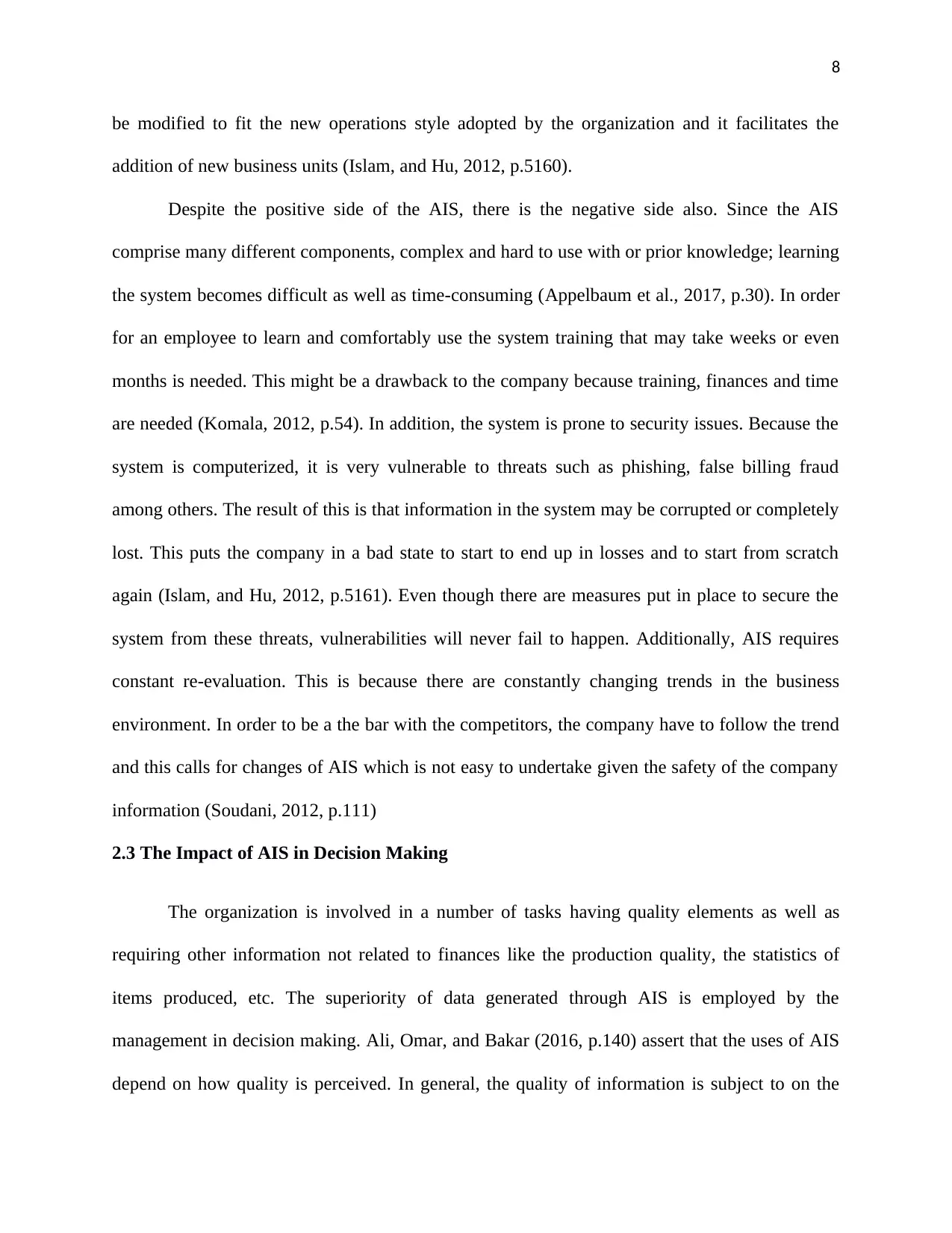
8
be modified to fit the new operations style adopted by the organization and it facilitates the
addition of new business units (Islam, and Hu, 2012, p.5160).
Despite the positive side of the AIS, there is the negative side also. Since the AIS
comprise many different components, complex and hard to use with or prior knowledge; learning
the system becomes difficult as well as time-consuming (Appelbaum et al., 2017, p.30). In order
for an employee to learn and comfortably use the system training that may take weeks or even
months is needed. This might be a drawback to the company because training, finances and time
are needed (Komala, 2012, p.54). In addition, the system is prone to security issues. Because the
system is computerized, it is very vulnerable to threats such as phishing, false billing fraud
among others. The result of this is that information in the system may be corrupted or completely
lost. This puts the company in a bad state to start to end up in losses and to start from scratch
again (Islam, and Hu, 2012, p.5161). Even though there are measures put in place to secure the
system from these threats, vulnerabilities will never fail to happen. Additionally, AIS requires
constant re-evaluation. This is because there are constantly changing trends in the business
environment. In order to be a the bar with the competitors, the company have to follow the trend
and this calls for changes of AIS which is not easy to undertake given the safety of the company
information (Soudani, 2012, p.111)
2.3 The Impact of AIS in Decision Making
The organization is involved in a number of tasks having quality elements as well as
requiring other information not related to finances like the production quality, the statistics of
items produced, etc. The superiority of data generated through AIS is employed by the
management in decision making. Ali, Omar, and Bakar (2016, p.140) assert that the uses of AIS
depend on how quality is perceived. In general, the quality of information is subject to on the
be modified to fit the new operations style adopted by the organization and it facilitates the
addition of new business units (Islam, and Hu, 2012, p.5160).
Despite the positive side of the AIS, there is the negative side also. Since the AIS
comprise many different components, complex and hard to use with or prior knowledge; learning
the system becomes difficult as well as time-consuming (Appelbaum et al., 2017, p.30). In order
for an employee to learn and comfortably use the system training that may take weeks or even
months is needed. This might be a drawback to the company because training, finances and time
are needed (Komala, 2012, p.54). In addition, the system is prone to security issues. Because the
system is computerized, it is very vulnerable to threats such as phishing, false billing fraud
among others. The result of this is that information in the system may be corrupted or completely
lost. This puts the company in a bad state to start to end up in losses and to start from scratch
again (Islam, and Hu, 2012, p.5161). Even though there are measures put in place to secure the
system from these threats, vulnerabilities will never fail to happen. Additionally, AIS requires
constant re-evaluation. This is because there are constantly changing trends in the business
environment. In order to be a the bar with the competitors, the company have to follow the trend
and this calls for changes of AIS which is not easy to undertake given the safety of the company
information (Soudani, 2012, p.111)
2.3 The Impact of AIS in Decision Making
The organization is involved in a number of tasks having quality elements as well as
requiring other information not related to finances like the production quality, the statistics of
items produced, etc. The superiority of data generated through AIS is employed by the
management in decision making. Ali, Omar, and Bakar (2016, p.140) assert that the uses of AIS
depend on how quality is perceived. In general, the quality of information is subject to on the
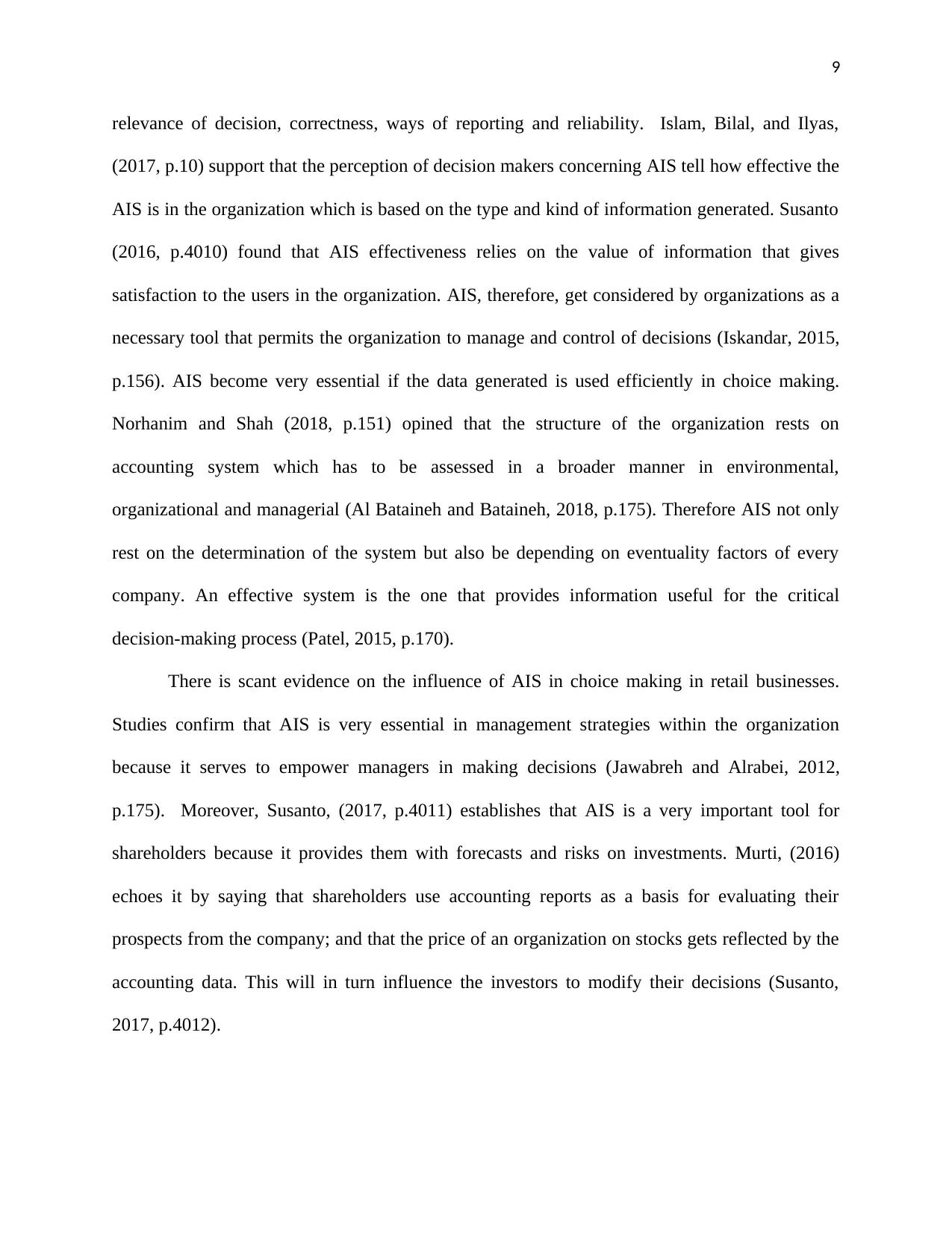
9
relevance of decision, correctness, ways of reporting and reliability. Islam, Bilal, and Ilyas,
(2017, p.10) support that the perception of decision makers concerning AIS tell how effective the
AIS is in the organization which is based on the type and kind of information generated. Susanto
(2016, p.4010) found that AIS effectiveness relies on the value of information that gives
satisfaction to the users in the organization. AIS, therefore, get considered by organizations as a
necessary tool that permits the organization to manage and control of decisions (Iskandar, 2015,
p.156). AIS become very essential if the data generated is used efficiently in choice making.
Norhanim and Shah (2018, p.151) opined that the structure of the organization rests on
accounting system which has to be assessed in a broader manner in environmental,
organizational and managerial (Al Bataineh and Bataineh, 2018, p.175). Therefore AIS not only
rest on the determination of the system but also be depending on eventuality factors of every
company. An effective system is the one that provides information useful for the critical
decision-making process (Patel, 2015, p.170).
There is scant evidence on the influence of AIS in choice making in retail businesses.
Studies confirm that AIS is very essential in management strategies within the organization
because it serves to empower managers in making decisions (Jawabreh and Alrabei, 2012,
p.175). Moreover, Susanto, (2017, p.4011) establishes that AIS is a very important tool for
shareholders because it provides them with forecasts and risks on investments. Murti, (2016)
echoes it by saying that shareholders use accounting reports as a basis for evaluating their
prospects from the company; and that the price of an organization on stocks gets reflected by the
accounting data. This will in turn influence the investors to modify their decisions (Susanto,
2017, p.4012).
relevance of decision, correctness, ways of reporting and reliability. Islam, Bilal, and Ilyas,
(2017, p.10) support that the perception of decision makers concerning AIS tell how effective the
AIS is in the organization which is based on the type and kind of information generated. Susanto
(2016, p.4010) found that AIS effectiveness relies on the value of information that gives
satisfaction to the users in the organization. AIS, therefore, get considered by organizations as a
necessary tool that permits the organization to manage and control of decisions (Iskandar, 2015,
p.156). AIS become very essential if the data generated is used efficiently in choice making.
Norhanim and Shah (2018, p.151) opined that the structure of the organization rests on
accounting system which has to be assessed in a broader manner in environmental,
organizational and managerial (Al Bataineh and Bataineh, 2018, p.175). Therefore AIS not only
rest on the determination of the system but also be depending on eventuality factors of every
company. An effective system is the one that provides information useful for the critical
decision-making process (Patel, 2015, p.170).
There is scant evidence on the influence of AIS in choice making in retail businesses.
Studies confirm that AIS is very essential in management strategies within the organization
because it serves to empower managers in making decisions (Jawabreh and Alrabei, 2012,
p.175). Moreover, Susanto, (2017, p.4011) establishes that AIS is a very important tool for
shareholders because it provides them with forecasts and risks on investments. Murti, (2016)
echoes it by saying that shareholders use accounting reports as a basis for evaluating their
prospects from the company; and that the price of an organization on stocks gets reflected by the
accounting data. This will in turn influence the investors to modify their decisions (Susanto,
2017, p.4012).
⊘ This is a preview!⊘
Do you want full access?
Subscribe today to unlock all pages.

Trusted by 1+ million students worldwide
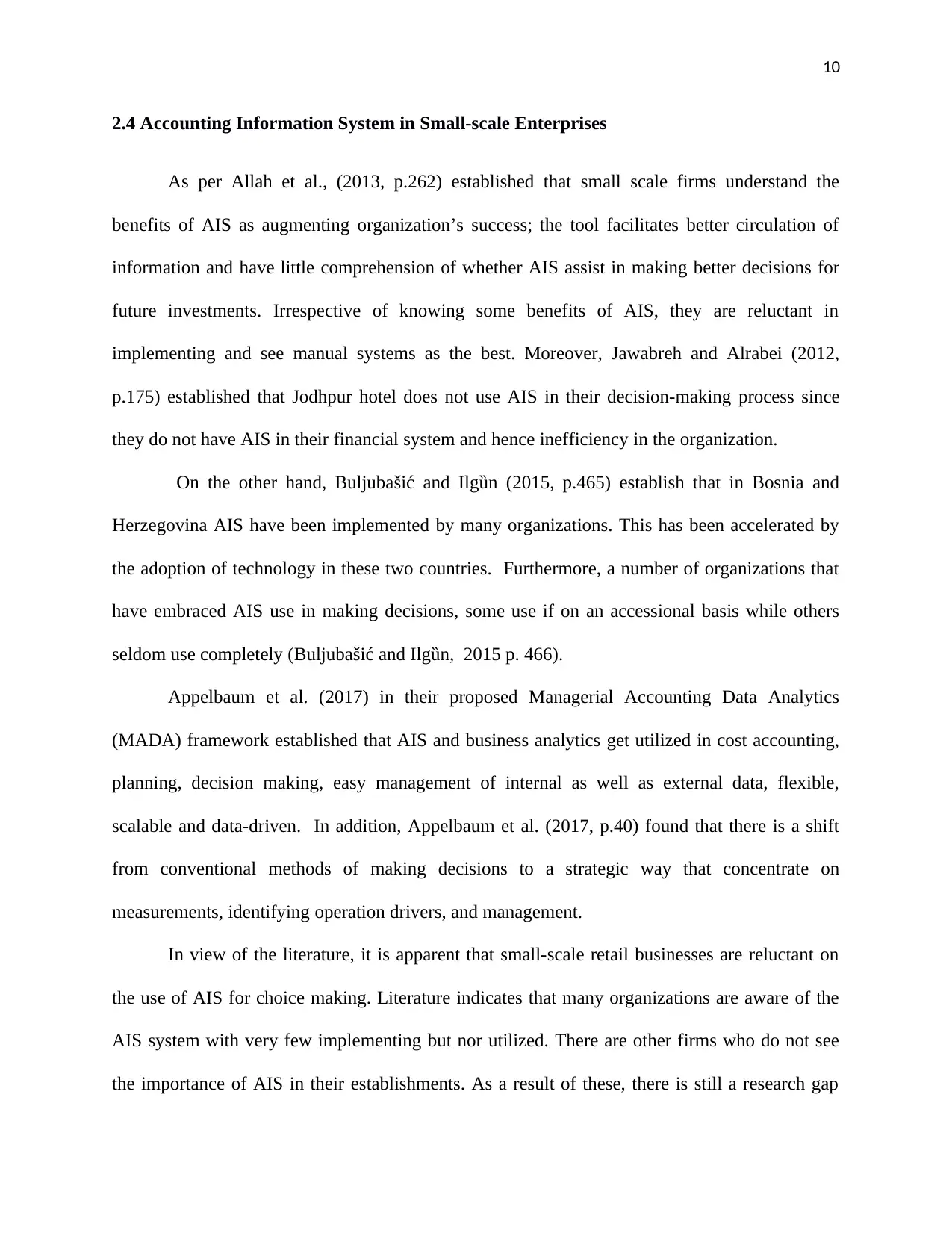
10
2.4 Accounting Information System in Small-scale Enterprises
As per Allah et al., (2013, p.262) established that small scale firms understand the
benefits of AIS as augmenting organization’s success; the tool facilitates better circulation of
information and have little comprehension of whether AIS assist in making better decisions for
future investments. Irrespective of knowing some benefits of AIS, they are reluctant in
implementing and see manual systems as the best. Moreover, Jawabreh and Alrabei (2012,
p.175) established that Jodhpur hotel does not use AIS in their decision-making process since
they do not have AIS in their financial system and hence inefficiency in the organization.
On the other hand, Buljubašić and Ilgȕn (2015, p.465) establish that in Bosnia and
Herzegovina AIS have been implemented by many organizations. This has been accelerated by
the adoption of technology in these two countries. Furthermore, a number of organizations that
have embraced AIS use in making decisions, some use if on an accessional basis while others
seldom use completely (Buljubašić and Ilgȕn, 2015 p. 466).
Appelbaum et al. (2017) in their proposed Managerial Accounting Data Analytics
(MADA) framework established that AIS and business analytics get utilized in cost accounting,
planning, decision making, easy management of internal as well as external data, flexible,
scalable and data-driven. In addition, Appelbaum et al. (2017, p.40) found that there is a shift
from conventional methods of making decisions to a strategic way that concentrate on
measurements, identifying operation drivers, and management.
In view of the literature, it is apparent that small-scale retail businesses are reluctant on
the use of AIS for choice making. Literature indicates that many organizations are aware of the
AIS system with very few implementing but nor utilized. There are other firms who do not see
the importance of AIS in their establishments. As a result of these, there is still a research gap
2.4 Accounting Information System in Small-scale Enterprises
As per Allah et al., (2013, p.262) established that small scale firms understand the
benefits of AIS as augmenting organization’s success; the tool facilitates better circulation of
information and have little comprehension of whether AIS assist in making better decisions for
future investments. Irrespective of knowing some benefits of AIS, they are reluctant in
implementing and see manual systems as the best. Moreover, Jawabreh and Alrabei (2012,
p.175) established that Jodhpur hotel does not use AIS in their decision-making process since
they do not have AIS in their financial system and hence inefficiency in the organization.
On the other hand, Buljubašić and Ilgȕn (2015, p.465) establish that in Bosnia and
Herzegovina AIS have been implemented by many organizations. This has been accelerated by
the adoption of technology in these two countries. Furthermore, a number of organizations that
have embraced AIS use in making decisions, some use if on an accessional basis while others
seldom use completely (Buljubašić and Ilgȕn, 2015 p. 466).
Appelbaum et al. (2017) in their proposed Managerial Accounting Data Analytics
(MADA) framework established that AIS and business analytics get utilized in cost accounting,
planning, decision making, easy management of internal as well as external data, flexible,
scalable and data-driven. In addition, Appelbaum et al. (2017, p.40) found that there is a shift
from conventional methods of making decisions to a strategic way that concentrate on
measurements, identifying operation drivers, and management.
In view of the literature, it is apparent that small-scale retail businesses are reluctant on
the use of AIS for choice making. Literature indicates that many organizations are aware of the
AIS system with very few implementing but nor utilized. There are other firms who do not see
the importance of AIS in their establishments. As a result of these, there is still a research gap
Paraphrase This Document
Need a fresh take? Get an instant paraphrase of this document with our AI Paraphraser

11
that needs to be filled and thus the researcher endeavors to establish the influence of AIS in
choice making in retail businesses in Sydney, Australia. Australia and specifically selected for
the study because there is not much research done on this based Sydney given that the region that
has fully embraced technology.
that needs to be filled and thus the researcher endeavors to establish the influence of AIS in
choice making in retail businesses in Sydney, Australia. Australia and specifically selected for
the study because there is not much research done on this based Sydney given that the region that
has fully embraced technology.
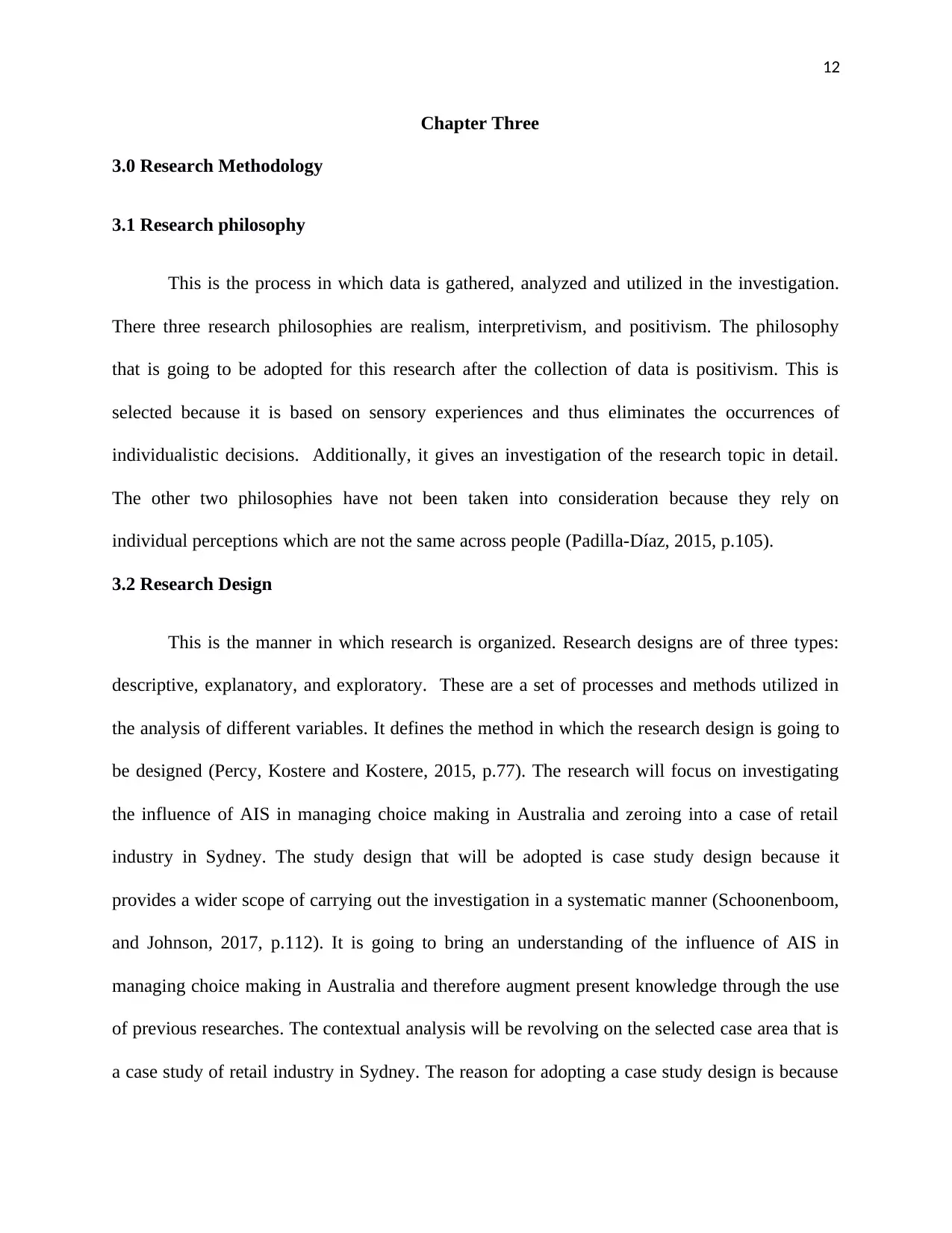
12
Chapter Three
3.0 Research Methodology
3.1 Research philosophy
This is the process in which data is gathered, analyzed and utilized in the investigation.
There three research philosophies are realism, interpretivism, and positivism. The philosophy
that is going to be adopted for this research after the collection of data is positivism. This is
selected because it is based on sensory experiences and thus eliminates the occurrences of
individualistic decisions. Additionally, it gives an investigation of the research topic in detail.
The other two philosophies have not been taken into consideration because they rely on
individual perceptions which are not the same across people (Padilla-Díaz, 2015, p.105).
3.2 Research Design
This is the manner in which research is organized. Research designs are of three types:
descriptive, explanatory, and exploratory. These are a set of processes and methods utilized in
the analysis of different variables. It defines the method in which the research design is going to
be designed (Percy, Kostere and Kostere, 2015, p.77). The research will focus on investigating
the influence of AIS in managing choice making in Australia and zeroing into a case of retail
industry in Sydney. The study design that will be adopted is case study design because it
provides a wider scope of carrying out the investigation in a systematic manner (Schoonenboom,
and Johnson, 2017, p.112). It is going to bring an understanding of the influence of AIS in
managing choice making in Australia and therefore augment present knowledge through the use
of previous researches. The contextual analysis will be revolving on the selected case area that is
a case study of retail industry in Sydney. The reason for adopting a case study design is because
Chapter Three
3.0 Research Methodology
3.1 Research philosophy
This is the process in which data is gathered, analyzed and utilized in the investigation.
There three research philosophies are realism, interpretivism, and positivism. The philosophy
that is going to be adopted for this research after the collection of data is positivism. This is
selected because it is based on sensory experiences and thus eliminates the occurrences of
individualistic decisions. Additionally, it gives an investigation of the research topic in detail.
The other two philosophies have not been taken into consideration because they rely on
individual perceptions which are not the same across people (Padilla-Díaz, 2015, p.105).
3.2 Research Design
This is the manner in which research is organized. Research designs are of three types:
descriptive, explanatory, and exploratory. These are a set of processes and methods utilized in
the analysis of different variables. It defines the method in which the research design is going to
be designed (Percy, Kostere and Kostere, 2015, p.77). The research will focus on investigating
the influence of AIS in managing choice making in Australia and zeroing into a case of retail
industry in Sydney. The study design that will be adopted is case study design because it
provides a wider scope of carrying out the investigation in a systematic manner (Schoonenboom,
and Johnson, 2017, p.112). It is going to bring an understanding of the influence of AIS in
managing choice making in Australia and therefore augment present knowledge through the use
of previous researches. The contextual analysis will be revolving on the selected case area that is
a case study of retail industry in Sydney. The reason for adopting a case study design is because
⊘ This is a preview!⊘
Do you want full access?
Subscribe today to unlock all pages.

Trusted by 1+ million students worldwide
1 out of 21
Related Documents
Your All-in-One AI-Powered Toolkit for Academic Success.
+13062052269
info@desklib.com
Available 24*7 on WhatsApp / Email
![[object Object]](/_next/static/media/star-bottom.7253800d.svg)
Unlock your academic potential
Copyright © 2020–2025 A2Z Services. All Rights Reserved. Developed and managed by ZUCOL.





